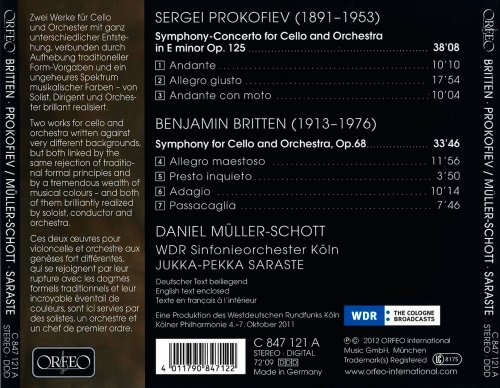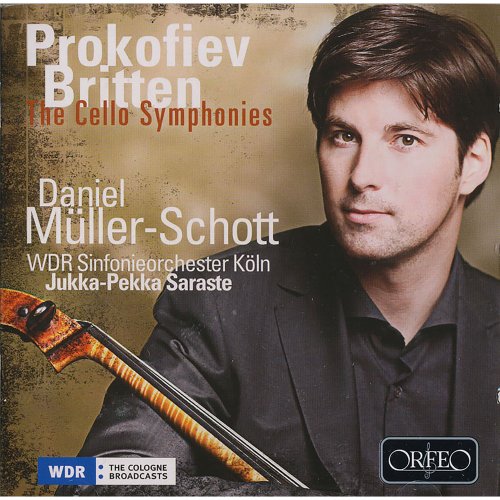
Daniel Müller-Schott, WDR Sinfonieorchester Köln, Jukka-Pekka Saraste - Prokofiev: Symphony concertante - Britten: Symphony for Cello & Orchestra (2012)
BAND/ARTIST: Daniel Müller-Schott, WDR Sinfonieorchester Köln, Jukka-Pekka Saraste
- Title: Prokofiev: Symphony concertante - Britten: Symphony for Cello & Orchestra
- Year Of Release: 2012
- Label: Orfeo
- Genre: Classical
- Quality: flac lossless (tracks) +Booklet
- Total Time: 01:12:07
- Total Size: 327 mb
- WebSite: Album Preview
Tracklist
01. Sinfonia concertante in E Minor, Op. 125: I. Andante
02. Sinfonia concertante in E Minor, Op. 125: II. Allegro giusto
03. Sinfonia concertante in E Minor, Op. 125: III. Andante con moto
04. Symphony for Cello & Orchestra, Op. 68: I. Allegro maestoso
05. Symphony for Cello & Orchestra, Op. 68: II. Presto inquieto
06. Symphony for Cello & Orchestra, Op. 68: III. Adagio
07. Symphony for Cello & Orchestra, Op. 68: IV. Passacaglia. Andante allegro

Following his recording of Britten’s Cello Suites, Daniel Müller-Schott is now exploring other areas of the repertoire opened up by the legendary Mstislav Rostropovich. The Symphony for Cello and Orchestra was the first major work after the Cello Sonata of 1961 that Britten was inspired to compose when an ailing Rostropovich wrote to him to claim that only “the doctor in Aldeburgh” could bring him “back to life by composing a brilliant cello concerto”. For Daniel Müller-Schott, who spent a year studying with Rostropovich, it is very much the work’s classical four-movement design that represents a challenge that is especially rewarding for the listener, with its interplay between chamber-like ensemble and symphonic rivalry with the orchestra. In the WDR Symphony Orchestra of Cologne under its principal conductor Jukka-Pekka Saraste, the cellist has found like-minded partners eminently capable of bringing out the clear thematic structure of the work, including its expressionistic climaxes and its interplay between stasis and motion, all of which are traced by soloist and orchestra with breathtaking brilliance. The same is true of Prokofiev’s Symphony-Concerto in E minor for cello and orchestra, a piece that the composer repeatedly revised and which was taken up again by Rostropovich after Prokofiev’s death and introduced to international audiences. Daniel Müller-Schott follows in his mentor’s footsteps, demonstrating both his agility and sovereign command of every register of his instrument, mastering the changes of register and enormously difficult intervals with awesome ease. Particularly captivating is the vast range of contrasts in all three movements of the piece, which begins by striking a cantabile note reminiscent of the sound world of Prokofiev’s ballet 'Romeo and Juliet' and ending in a neoclassical set of variations of the final movement, which culminates in a positively playful dance. So irresistible is the dominant brilliance that one would like to hear both Prokofiev’s 'Symphony-Concerto' and Britten’s 'Symphony for Cello and Orchestra' performed far more frequently in the concert hall.
01. Sinfonia concertante in E Minor, Op. 125: I. Andante
02. Sinfonia concertante in E Minor, Op. 125: II. Allegro giusto
03. Sinfonia concertante in E Minor, Op. 125: III. Andante con moto
04. Symphony for Cello & Orchestra, Op. 68: I. Allegro maestoso
05. Symphony for Cello & Orchestra, Op. 68: II. Presto inquieto
06. Symphony for Cello & Orchestra, Op. 68: III. Adagio
07. Symphony for Cello & Orchestra, Op. 68: IV. Passacaglia. Andante allegro

Following his recording of Britten’s Cello Suites, Daniel Müller-Schott is now exploring other areas of the repertoire opened up by the legendary Mstislav Rostropovich. The Symphony for Cello and Orchestra was the first major work after the Cello Sonata of 1961 that Britten was inspired to compose when an ailing Rostropovich wrote to him to claim that only “the doctor in Aldeburgh” could bring him “back to life by composing a brilliant cello concerto”. For Daniel Müller-Schott, who spent a year studying with Rostropovich, it is very much the work’s classical four-movement design that represents a challenge that is especially rewarding for the listener, with its interplay between chamber-like ensemble and symphonic rivalry with the orchestra. In the WDR Symphony Orchestra of Cologne under its principal conductor Jukka-Pekka Saraste, the cellist has found like-minded partners eminently capable of bringing out the clear thematic structure of the work, including its expressionistic climaxes and its interplay between stasis and motion, all of which are traced by soloist and orchestra with breathtaking brilliance. The same is true of Prokofiev’s Symphony-Concerto in E minor for cello and orchestra, a piece that the composer repeatedly revised and which was taken up again by Rostropovich after Prokofiev’s death and introduced to international audiences. Daniel Müller-Schott follows in his mentor’s footsteps, demonstrating both his agility and sovereign command of every register of his instrument, mastering the changes of register and enormously difficult intervals with awesome ease. Particularly captivating is the vast range of contrasts in all three movements of the piece, which begins by striking a cantabile note reminiscent of the sound world of Prokofiev’s ballet 'Romeo and Juliet' and ending in a neoclassical set of variations of the final movement, which culminates in a positively playful dance. So irresistible is the dominant brilliance that one would like to hear both Prokofiev’s 'Symphony-Concerto' and Britten’s 'Symphony for Cello and Orchestra' performed far more frequently in the concert hall.
As a ISRA.CLOUD's PREMIUM member you will have the following benefits:
- Unlimited high speed downloads
- Download directly without waiting time
- Unlimited parallel downloads
- Support for download accelerators
- No advertising
- Resume broken downloads


